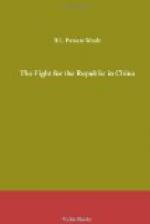The Senate now openly delivered itself over to the accomplishment of the scheme which had been broached by Yang Tu, the monarchist pamphleteer. Although this individual still posed as the leader of the movement, in reality he was nothing but the tool of a remarkable man, one Liang Shih-yi, famous throughout the country as the most unscrupulous and adroit politician the Revolution had thrown up. This person, who is known to have been gravely implicated in many assassinations, and who was the instrument used in 1912 by Yuan Shih-kai to persuade the Manchu Imperial Family to abdicate, had in a brief four years accumulated a vast fortune by the manipulations he had indulged in as Director-General of The Bank of Communications, an institution which, because it disposed of all the railway receipts, was always in funds even when the Central Treasury itself was empty. By making himself financially indispensable to Yuan Shih-kai he had become recognized as the power behind the Throne; for although, owing to foreign clamour, he had been dismissed from his old office of Chief Secretary to the President (which he had utilized to effect the sale of offices far and wide) he was a daily visitor to the Presidential Palace and his creatures daily pulled all the numerous strings.
The scheme now adopted by the Senate was to cause the provinces to flood Peking with petitions, sent up through the agency of “The Society for the Preservation of Peace,” demanding that the Republic be replaced by that form of government which the people alone understood, the name Constitutional Monarchy being selected merely as a piece of political window-dressing to please the foreign world. A vast amount of organizing had to be done behind the scenes before the preliminaries were completed: but on the 6th October the scheme was so far advanced that in response to “hosts of petitions” the Senate, sitting in its capacity of Legislative Chamber (Li Fa Yuan) passed a so-called King-making bill in which elaborate regulations were adopted for referring the question under discussion to a provincial referendum. According to this naive document the provinces were to be organized into electoral colleges, and the votes of the electors, after being recorded, were to be sent up to Peking for scrutiny. Some attempt was made to follow Dr. Goodnow’s advice to secure as far as possible that the various classes of the community should be specially represented: and provision was therefore made in the voting for the inclusion of “learned scholars,” Chambers of Commerce, and “oversea merchants,” whose votes were to be directly recorded by their special delegates. To secure uniformly satisfactory results, the whole election was placed absolutely and without restriction in the hands of the high provincial authorities, who were invited to bestow on the matter their most earnest attention.




